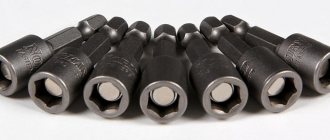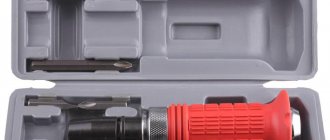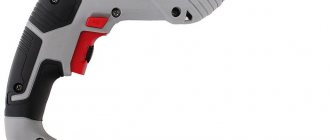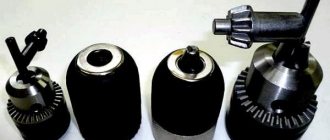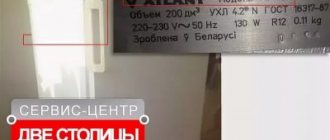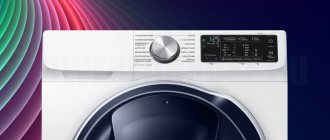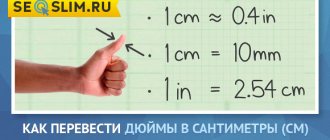Working with a large number of fasteners - bolts or screws - requires mechanization. Otherwise, no performance will be achieved, and the quality of fastener tightening will decrease as calluses appear on the palms. The invention of screwdrivers and replacement equipment for them made it possible to change the situation and make the process of joining parts more efficient and stable. The procedure no longer depended on the employee’s condition and was significantly sped up.
The emergence of different types of spline joints required a quick change of attachment, which finally determined the design of modern screwdrivers. Today, the number of types of replacement equipment is very large. Choosing the best option becomes difficult, since you have to take into account the features and specifics of the operation of a particular type of bit. Let's take a closer look at them.
Slotted bits
The very first screwdriver to be invented was a slotted screwdriver; it was invented in the 16th century. It was widespread during the Soviet period. Today, there are also types of screwdriver bits made for straight slots, but they are used less frequently. Such bits are designated by the letter S. This marking is placed on one of the edges of the bits.
The Latin letter S is an abbreviation for the English word slot, meaning “slit” or “slot.” There is also an alternative designation - slotted. This word when translated into Russian means “slotted”. There is always a number next to the letter indicating the width of the tip. In some cases, its thickness is additionally indicated.
The ratio of the width and thickness of the most common slotted bits:
| Width, mm | 2,0 | 2,5 | 3,0 | 3,5 | 4,0 | 4,5 | 5,0 | 5,5 | 6,0; 6,5; 7,0 | 8,0 | 9,0 |
| Thickness, mm | 0,3 — 0,4 | 0,4 | 0,5 | 0,5 — 0,6 | 0,6 — 0,8 | 0,6 | 0,8 | 0,8 — 1,0 | 1,0 — 1,2 | 1,2 — 1,6 | 1,4 — 1,6 |
Next, we will look at some types of bits for straight slots.
Classic straight bit
Width and thickness are the two main dimensions of a straight spline. In most cases, only the first parameter is specified. It varies from 3.0 to 9.0 mm. The second parameter is often not indicated, but its value can range from 0.5 to 1.6 mm. The peculiarity of this marking is due to the fact that the width and thickness have a standard ratio. The surface of the flat-slotted bits is protected from erosion and has increased hardness.
Bit with straight slot and TIN coating
These bits have a golden color because the surface of the bits is coated with titanium nitride as a result of the CVD chemical process. Thanks to this, the devices have a durable surface. Such nozzles may differ from each other only in width. This value ranges from 4.5 to 6.5 mm. The markings of the devices may also indicate their thickness. This value ranges from 0.6 to 1.2 mm.
Extended slotted bit
Thanks to the elongated part of the device, it is possible to carry out the necessary work more accurately. When used, the tip of this attachment is firmly placed in the head of the screw or screw. Using this bit it is convenient to perform small installation processes. A distinctive feature of these devices is the length of the nozzles, which ranges from 50 mm to 100 mm.
Advantages and disadvantages
The advantages of screwdriver bits include:
- Wide selection of varieties and sizes.
- High speed of tool change.
- All types of bits are standardized and have the same shank.
- There is a set of bits for every type of fastener.
- There are expensive and quite affordable equipment kits.
The disadvantages of bits are considered to be:
- If the bat doesn't fit properly, it becomes useless.
- Loose contact between the slot and the bit can cause destruction of both elements.
- A large number of varieties and sizes makes it difficult to select the optimal option.
Expert opinion
Kulikov Vladimir Sergeevich
The disadvantages of the equipment are due to the specifics of use and are completely surmountable. They can be considered a design feature. Despite them, the use and demand for bits is constantly increasing.
Cross bits (Phillips)
The cross-shaped bat first appeared in the first half of the 20th century. This was facilitated by the fact that when using fasteners and slotted screwdrivers in the automotive industry, when assembling parts, they often slipped out of the heads of screws and screws, which led to damage to the varnished coating of the vehicle. Also, the threads of fasteners often broke due to the fact that torque limiters, which later began to be used in mechanical screwdrivers and screwdrivers, had not yet been invented.
All of these reasons contributed to the invention of the Phillips screw in 1933 by John Thompson. Three years later, the patent for this invention was acquired by Henry Phillips. This engineer refined the production technology and in 1937 invited Eugene Clark, who was a major manufacturer of metal products, to hold a competition to see who could tighten the screws the fastest.
Naturally, Henry Phillips won the competition. After this, a new type of attachment attracted the attention of US automakers, but World War II soon began. Therefore, the cross-head slot appeared in Europe, along with the supply of American military equipment.
The first cross-shaped nozzle was called "Phillips" in honor of Henry Phillips. Bits of this type are marked with the letters PH. They are followed by a number rigidly associated with the diameter of the external thread of the fastener. This standard is used for all types of Phillips bits.
Standard ratios between the number of the PH type cross bit and the external thread of the fastener:
| Bit number | 0 | 1 | 2 | 3 | 4 |
| Thread diameter, mm | less than 2.0 | 2,1 — 3,0 | 3,1 — 5,0 | 5,1 — 7,0 | more than 7.1 |
Classic cross bat PH
These nozzles differ in size, which range from 0 to 4. The most commonly used crosspiece is No. 2, as it allows you to work with metal and wooden materials. Large nozzles numbered 3 and 4 are used less frequently. They are most often used when repairing cars and large items.
Cross bit with PH slot and TIN coating
Titanium nitride is used to coat the nozzle. This is evidenced by the golden color of the bat. The nozzle can withstand heavy loads. The slot can be made in one of three sizes: PH 1, 2 or 3.
Long cross bit PH
An extended nozzle with a cross-shaped PH slot can be used for tightening fasteners in hard-to-reach places. Such devices are especially effective when unscrewing fasteners. Most often you can find nozzles with a length of 50, 70, 90, 110, 125, 150 mm. Available in three sizes PH 1, 2, 3.
What is a bit, principle of operation
A bat is a special attachment for hand and mechanical tools for screwing screws, self-tapping screws, nails, screws, anchors, etc.: all this is called the general concept of hardware. A hand tool means a screwdriver, a mechanical tool means a screwdriver, drill, screwdriver. One end of the bit is fixed in the tool, and the other directly twists the hardware. The tips of the nozzles are made in such a way that they repeat the grooves of the fasteners. Due to this, the hardware is given a torque, ensuring easy screwing. The types of bits based on tip types, material of manufacture and other parameters will be discussed further.
Cross bits (Pozidriv)
Later, specifically for the production of furniture and construction work, Philips Screw Company developed a new type of cross-head slot. It was named Pozidriv. This type of spline was patented in 1966. The bits for this slot are marked with the letters PZ. They are designed to work with wood or other similar materials that have a heterogeneous structure. At the same time, PH type bits are more suitable for working with metal.
A distinctive feature of the PZ system, in comparison with the PH, is that the edges of the working surfaces are located parallel to each other and are made of the same thickness along their entire length, and the slot itself is much deeper. This design feature prevents the bit from being pushed out when tightening the fastener. Thanks to this, a tighter contact is formed between the screw head and the bit, which reduces wear on the elements. In this case, there is no need to apply large axial forces when the tip is pressed onto the slot.
It must be remembered that when choosing a bit for tightening fasteners for a PZ slot, you must use a PZ type bit. If you use a PH type nozzle to screw products into a PZ slot, the surfaces will not be in close contact with each other, which will shorten the life of the nozzle.
Classic cross-shaped PZ bit with serrations
Additional knurls are a distinctive feature of PZ bits when compared to PH bits. The great strength of the devices allows them to withstand enormous loads. The sizes of this type of bit for a screwdriver can be PZ 1, PZ 2, PZ 3.
Phillips bit PZ with serrations and TIN coating
The protective coating of this nozzle is made on the basis of titanium nitride. It significantly increases the durability of the bat. This is also facilitated by the hardened steel used for its manufacture. All this together made it possible to create a nozzle with optimal hardness and endurance. There are three sizes of the fixture: PZ 1, PZ 2 and PZ 3.
Extended cross-shaped nozzle PZ
This nozzle is available in three sizes: PZ 1, PZ 2, PZ 3, and can be 50, 70, 90, 110, 125 and 150 mm long.
Recommendations for choosing bits
A good bat can perform many more fastener tightening operations than its simplified counterpart. To choose the desired tool, you need to contact a retailer whose employees you trust and get the necessary recommendations. If this is not possible, choose bits from well-known manufacturers - Bosch, Makita, DeWALT, Milwaukee.
Pay attention to the presence of a hardening titanium nitride coating, and also, if possible, to the material of the product. The best way to choose is to try out one or two pieces of equipment in your own business. This way you will not only determine the quality of the product yourself, but will also be able to give recommendations to your friends. Perhaps you will settle on an inexpensive option that has clear economic or technical advantages over the originals of famous companies.
High-quality screwdriver attachments can always be purchased at the Stroybat online store for professional fasteners.
Hex bits (Hex)
Another, less popular, but often used is the hexagonal slot. This form of notch first appeared in 1910 and was called Hex socket. This phrase means internal hexagon. It was first used on the factory floors of the Allen Manufacturing Company. The letter H is used to mark these bits. The Hex system features a large amount of torque that can be applied to the head of the fastener as it is tightened. In this case, there is no possibility of damage to the nozzle and the slot breaking off.
The distance between the sides of the hex blade is the main characteristic that distinguishes these bits. If you take a 4 mm nozzle, it is perfect for screwing furniture confirmat. A so-called safe type of slot is also available. It is called Hex-Pin, which stands for protected hexagon. This slot is equipped with a special pin in the center. Its presence helps prevent unauthorized disassembly of the connection.
Classic hexagonal bat
These bits make it very convenient to work with the corresponding self-tapping screws and self-tapping screws, since they have a large area of contact with fasteners. They have been used in the United States for a long time, but their introduction in Russia occurred relatively recently. The sizes of these nozzles can vary from 1.5 to 10 mm.
Hexagonal shaped bit with hole inside
A reliable bit of this type is easy to use. During its use, a person does not need to exert much physical force. Thanks to the presence of the hole, the device does not slip off. The size of the nozzle ranges from 1.5 to 6 mm.
Extended hex bit
This attachment is marked with the Hex- symbol. She is rarely seen at work. Despite this, it has proven itself well, as it is practical and convenient. High quality steel is used to make this bat. Due to this, it has good strength. Its dimensions range from 3 to 8 mm, and the length of such attachments varies from 50 to 100 mm.
Classification of screwdriver bits
Screwdriver mounting attachments are classified according to the following parameters:
- material;
- form;
- type of construction;
- head dimensions and shaft length.
By material and coating
Of primary importance is the material from which the nozzle is made. After all, the mere correspondence of the tip to the grooves of the hardware will not make the bat more durable. In order not to have to change the nozzle every time after several uses just because it cannot withstand the load, breaks or is deformed, you need to choose from the following materials:
- carbon steel grades R7-R12;
- tool steel grade S2;
- chromium alloys with vanadium;
- alloys of molybdenum with tungsten or chromium.
In addition to the material itself, the coating of the nozzle is important. It provides the bat with higher strength and corrosion resistance. The most reliable types of coatings:
- chromium vanadium alloy
- tungsten nickel alloy
- titanium nitride alloy;
- coating made from a mixture of tungsten, carbon and diamond chips.
The titanium nitride coating is easily distinguished by its golden color, while the diamond layer adds shine to the tip.
Golden color titanium nitride coating
Form
According to their shape, bits for screwdrivers have the following classification:
- Flat. The most standard and common type. Another name is slotted bits. Used for tightening screws and self-tapping screws in wood and plasterboard surfaces. The end has a flat slot, like a screwdriver. Its width is 3-7 mm, its length varies.
- Cross-shaped. At the end of the nozzle, 4 ribs converge, forming a flat cross. Due to this, the screwdriver receives reliable adhesion to the grooves in the hardware head. These attachments are more stable than flat ones - they can be used for both wood and metal. The width of the cross is from 2 to 7.1 mm.
- Cross-shaped improved. Here between the four main ribs there are 4 additional spline notches. That is, the tip has 2 crosses. They provide increased adhesion density, and due to this, it is convenient to use such nozzles, for example, on chipboard panels. The width of the main cross is from 3 to 6.3 mm.
Cross-shaped improved
- Hexagonal. The main areas of application for bits of this type are mechanical engineering and furniture production. Suitable only for hardware with a hexagonal groove on the head. Standards for hexagonal tip width are from 1.5 to 10 mm, lengths are from 5 to 10 cm.
- In the form of a six-pointed star. There are 6 ribs at the working end of the slot, which is why the tip looks like a star. The load during adhesion to hardware and torsion is evenly distributed in 6 directions at once - this makes the part stronger and more durable in comparison with, for example, cruciform ones. Screwdrivers with such attachments are usually used not around the house, but in mechanical engineering and installation.
- Bits for nuts and bolts. They have the same hexagon at the base to create maximum adhesion to the hardware. Suitable for tightening nuts and bolts with a diameter of 5 mm to 1.3 cm.
Construction type
According to the design features, screwdriver attachments can be single or double, as well as regular or torsion. The single bit is equipped with a hexagonal tail for mounting in the tool and a working tip at the opposite end. The double one has working tips on both sides, sometimes of different sizes and types. This bit can last twice as long and can work on a variety of surfaces.
Double
A regular nozzle is straight, unbendable, and can only be used in one direction, at a certain angle. The torsion element is designed differently. Between the shank and the tip there is a spring, usually hidden under a red, blue or other colored area. When twisted, it ensures the bend of the bit, and this greatly simplifies the work.
Torsion bar
A torsion bar has a number of advantages over a regular one:
- easier to reach hard-to-reach places;
- the bit takes on only part of the tangential load - the rest falls on the spring;
- working with materials that are too hard for a regular attachment.
There is another special design aspect of screwdriver bits. Some models are equipped with a magnetic tip or spring attachment. This allows you to work in hard-to-reach places. The purpose of the magnetic tip is to tightly fix the drill in the grooves of the hardware, minimizing the risk of the bit slipping. It also promotes deeper screwing of the fasteners. Using a spring attachment, you can screw in hardware at different angles: the spring allows bending even more than 90°.
Magnetic screwdriver attachments
Important! Impact screwdrivers with torsion bits apply force not to the hardware head itself, but tangentially. This extends the life of both the fastener and the working tip.
Star Bits (Torx)
Star-shaped nozzles are used in the mechanical engineering field and in the production of household appliances for tightening fasteners with the appropriate head shape. They are called Torx and are designated by the letters TX or T. Next to the letter is a number that indicates the size of the nozzle. It corresponds to the distance between the rays of a hexagonal star.
Torx was first used in 1967 by Textron in America. Today, different types of bits are used for this type of screwdriver. So, there is a vandal-proof version equipped with an internal hole. It is designated by the letters TR, which stands for Torx Tamper Resistant. Five-point bits called Torx Brigadier Pentahedron are also used.
Classic bit "Star" (Torx)
In European countries and the USA, the Torx nozzle is the most popular of all existing slot shapes. This is due to its high performance. This bit is distinguished by the presence of six edges, with the help of which contact with a screw or screw occurs.
The design feature of the nozzle improves adhesion to the surface of the fastener. Thanks to this, you do not need to exert much effort to create torque. The likelihood of the device slipping is also reduced, since the load is distributed across 6 edges at once. In turn, this reduces their wear. Consequently, the service life of the bit increases significantly. “Star” nozzles are available in different sizes. The most common models are from T8 to T40. However, there are also smaller bits.
Star bit Torx Plus
Torx Plus is different in that its sprocket has less sharp rays, which are also shorter. These types of screwdriver bits require the master to have increased precision when performing work. High-hardness steel is used for their manufacture. The sizes of these nozzles are T10 - T40.
Star bit with TIN coating
Thanks to the presence of a coating based on titanium nitride, the nozzle has increased wear resistance. Its surface is rough and adheres well to steel. The nozzle is also more durable because it is made of hard material. The nozzle is sold in sizes from T10 to T40.
Star bit with a hole inside
This bit is often used in assembly plants. When tightening the fastener, the bit fits tightly into the fastener. As a result, the reliability of the tightening process increases, for the implementation of which no special effort is required. Bit sizes range from T10 to T40.
Extended bit "Star"
This attachment is convenient to use when performing certain types of work. Its dimensions are the same: from T10 to T40, length can be from 50 mm to 100 mm.
Popular makes and models
Screwdriver bits are consumables. They are produced by almost all tool manufacturers, as well as specialized companies.
Let's look at a few popular manufacturers:
Milwaukee Shockwave Impact Duty
Equipment from American manufacturers. The quality of the bits is evidenced by the test result - 6088 self-tapping screws were screwed using one bit. There are 5 types of tips with the most common sizes available;
DeWALT FlexTorq
A set of attachments from a well-known American company. Forged bits undergo hardening and final machine finishing. The nozzles are equipped with torsion cores that have a degree of freedom of 15°. This allows you to soften the moment of starting and stopping rotation;
Wiha MaxxTor
A series of German attachments characterized by a high angle of rotation of the torsion bars - 60°, in contrast to models from other companies that can only rotate by 15°. The equipment does not contain flat bits;
Wera Impaktor 851/4 IMP DC
A series of bits with a double torsion bar - one is located on the bit itself, the second is not on a special adapter. This increases the service life of the equipment and allows you to soften the blow when using special types of screwdrivers. The stings are diamond coated. The set is dominated by asterisks, but there are other types of bits.
Makita Impact Gold
A series of equipment from a Japanese company. The bits are made of high-strength titanium-coated steel. A special feature of the design is its double design, which reduces the number of units in the set without reducing functionality;
Bosch Impact Control
A series of bits made of high quality tool steel. The set includes both classic and elongated samples, which increases installation possibilities. There are regular and double-sided nozzles with all the most common types of stings. Users note the optimal combination of price and quality of the set;
Kraftool "Expert"
A set of accessories made in Taiwan. The composition includes 61 items, including bits of the most common types and sizes, and an adapter for increasing the length. It features a well-thought-out layout and high quality equipment.
The list of manufacturers and series can be continued for a long time. When choosing nozzles, you need to carefully study their characteristics, paying attention to the size, composition of the set, type of coating and other properties of the tools.
Square slotted bits (Robertson)
These attachments are specialized types of bits. In most cases, they are not used in conventional construction or renovation processes. The Robertson spline is one of the rarities and has a square section. Its full name is Robertson square. Nozzles of this shape are designated by the letter R.
Classic bat with four sides
Most often they are used during furniture assembly. These nozzles are available in 4 sizes: from No. 0 to No. 3.
Long bit with four edges
This attachment is not used very often. It is available in three sizes: No. 1,2 and 3 and can be from 50 to 70 mm long.
Rarely used types of bits for screwdrivers and screwdrivers
Now – about less common types of attachments:
- With square slot. Marked R, stands for Robertson. Not used in home repairs, intended for highly specialized work.
- Tetrahedral. Standard sizes – 0, 1, 2, 3. There are two types: classic and extended, 5-7 cm.
- Anti-vandal type Spanner Head. SP marking. This attachment also has other names: snake eye, fork head. At its end there are two parallel pins with a circle at the base.
Anti-vandal
- With flat fork slot. Marking GR, size standards - GR4, 6, 8, 10. The nozzles are made of durable high-quality steel and serve for a long time. In addition to the standard one, there is an extended model, 5-10 cm.
- With three blades. Marking TW, completely Tri-Wing. The tip is equipped with three straight blades. This element is used mainly in electronics and astronautics. Standard sizes – TW1, 2, 3, 4, 5, 6.
Three-blade
- With four blades. TS marking, completely Torq-Set. Similar to the previous type, only with one more blade. Sizes – from 4 to 10.
Bit with four blades
The most common types of attachments are:
- Pin-on-Hex – hexagonal slot with a rod in the middle;
- TR – sprocket with a rod in the center;
- Triple Square – multi-tooth spline;
- Polydrive - looks like a star with 6 blunt square ends;
- One-way or CL - two quarters of a circle: one - bottom left, the other - top right, or adjacent to each other at the corners;
Nozzle type CL
- octahedron and dodecahedron in the form of an asterisk;
- 12-pointed star;
- Bristol spline in the form of a gear.
Main and rare species
Bits with anti-vandal slot (Spanner head)
This slot is also called Snake-eye. In addition, it is also called a fork head. To mark bits with such a slot, the letters SP are used.
Classic bat "Fork"
High-quality steel is used in the manufacture of these nozzles. Thanks to it, the bits are characterized by increased strength and long-lasting durability. This attachment resembles a flat slotted bit that has a slot in the middle. The bat is available in 4 sizes, Gr. 4, 6, 8, 10.
Extended bit "Fork"
Available in 4 sizes and lengths from 50mm to 100mm.
Marking of different types of screwdriver bits
Each type of nozzle has its own marking standard. Information about brands of screwdriver bits by type is presented in the form of a table.
| Marking | Type |
| SL – Slotted | With flat slot. After the markings there are usually numbers - for example, 4.5x0.6. This means that the slot width is 4.5 mm and the thickness is 0.6 mm |
| PH – Phillips | Cross-shaped. After the letters there is a number from 0 to 4: this is the designation of the thread diameter. More about this in the next section. |
| PZ – Pozidriv | Cross-shaped improved. Numbers 1, 2, 3 indicate slot size |
| H-Hex | Hexagonal. Depending on the size, the value ranges from 1.5 to 10 |
| T – Torx | Star |
| R-Robertson | With square slot |
| SP – Spanner Head. Another name: Snake-eye | Anti-vandal slot in the form of a fork key |
| Tri-Wing | A bat with three blades located at an angle to each other |
Tri-Wing Splined Bits - Three Blade
When marking these attachments, the letters TW are used. A distinctive feature of these bits is the presence of 3 blades on the tip. They are used in the assembly of household appliances and electronics. They are also used in the aerospace industry. These bits first appeared in 1958 and were invented by Philips Screw Company. The size is designated by the letters Gr and can have indicators from Gr.1 to Gr.6.
The main types of polishing and grinding attachments for a screwdriver
Polishing and grinding attachments for screwdrivers are a large group of removable devices, including many varieties. In this category you can select tips to perform various tasks:
- polishing metal, wood and glass surfaces, as well as varnished products;
- cleaning products made of metal from corrosion and remnants of old paintwork;
- sanding wood and metal surfaces.
Thanks to the huge variety of attachments for a grinding screwdriver, you can choose tips for performing operations that cannot be carried out using standard methods.
Types of screwdriver attachments for grinding
There are more than ten types of screwdriver tips that can be used to grind a surface. Removable devices of this type consist of a rod on which an abrasive material is fixed:
- sandpaper;
Grinding screwdriver attachments consist of a rod on which an abrasive material is attached
- hard abrasive;
- hard fabric, such as felt;
- brushes.
The most popular among craftsmen are the following types of removable tips:
- Plates - these products can be rubber or plastic. Equipped with fixed and adjustable pins.
- End - made of hard and soft materials, can have different shapes (drum, washer, cone).
- Cup - brush attachments for a screwdriver with fibers made of brass or metal, as well as tips with soft filling made of foam rubber or felt.
- Disc - removable devices with soft padding or bristles made of brass or steel wire.
- Drum - sanding tape is used as an abrasive, suitable for processing holes and end zones of glass products.
- Fan - consist of several elements covered with sandpaper. Used for processing surfaces with complex geometry.
There are many varieties of grinding tips for screwdrivers.
Note! If desired, you can use a compact screwdriver with a socket attachment for processing jewelry. The tip is so precise that it allows you to grind fine details on precious metal jewelry.
Features of polishing attachments for screwdrivers
After processing the product with a polishing attachment, its surface becomes perfectly smooth. To do this, an end disk is used to remove the microscopic top layer of material. Thanks to this, the thickness of the product does not change.
Related article:
Drill attachments for various purposes for work in the home workshop
The main types of components for cutting, grinding, polishing and other tasks. Nozzles for working with metal, plastic, wood.
Screwdriver attachments for polishing various surfaces have a thrust circle with fasteners for fixing the polishing material. This element is held in place by a threaded end. Since the tool shaft can rotate both to the left and to the right, devices with connections of the appropriate type can be found on sale.
During operation, the polishing disc on the nozzle wears out, so it should be periodically replaced with a new one. Replacement products are thin (only a few millimeters). They are usually made from polyurethane. Although there are other options - made from felt or wool of natural or artificial origin.
There are options for polishing attachments for screwdrivers made of felt or wool
Some types of tips can be used for polishing car bodies and glass, as well as products made of polycarbonate. During operation, such attachments must be kept parallel to the surface being treated.
The main types of screwdriver attachments for cutting metal and wood
To perform many construction and repair work, a jigsaw is required; screwdriver attachments in the form of special scissors or a reciprocating saw can become an almost complete replacement for this tool.
Removable tips in the form of scissors for cutting metal come in several types:
- disk;
- turbo;
- die cutting;
- sectoral.
Each of them has its own operating principle and is designed for cutting sheets of a certain thickness.
The main purpose of a screwdriver when working with wood is to drill holes.
Review of screwdriver attachments for cutting sheet metal and plastic
Disc shears are equipped with two steel discs. One of them rotates due to the rotational movement transmitted from the chuck on the tool. The design of the cutting disc for a screwdriver is designed so that the metal is cut in a straight line, even without markings.
Disc shears are used in sheathing and roofing works using:
- metal tiles;
- galvanizing;
- siding;
- metal profile.
Note! Disc shears are maneuverable enough to create shaped pieces, but they cannot cope with the manufacture of complex metal parts.
Nibblers for a metal screwdriver are an attachment that is highly maneuverable and allows you to get a very precise cut. The edge turns out to be as smooth and neat as possible, so the possibility of cutting your hands when working with metal is almost completely eliminated.
Disc shears are used in sheathing and roofing work
Turbo scissors are an attachment for a screwdriver that works on the same principle as regular scissors, but cutting is much faster. This device is suitable for cutting metal sheets, plastic and other materials with a high degree of rigidity. The advantage of this attachment is that there is no vibration during operation. Thanks to this, the back of the claw does not damage the surface it touches.
This concludes the list of screwdriver attachments for cutting metal. Sector-type scissors are used when installing communication systems. They are suitable for cutting plastic pipes as well as power cables.
Scope of application and features of the saw attachment for a screwdriver
Even if you have a jigsaw in the house, some types of work simply cannot be performed using this tool. In such cases, the capabilities of a reciprocating saw will be useful. This type of screwdriver attachment is typically used for cutting wood, although it can be used to cut plastic and thin sheet metal. The reciprocating saw can also be used to care for the garden at your summer cottage. This type of device is suitable for pruning young trees.
The saw attachment on a screwdriver is used for cutting wood
Typically, the nozzle comes with three interchangeable blades of different lengths - 10, 15 and 23 cm (only an approximate value is indicated, which may vary depending on the manufacturer). Purchasing such a tip will cost several times less than purchasing an electric saw. The nozzle is capable of operating at a speed of about 2000 rpm.
The body of the removable device is made of very durable plastic. The blades are made from the same material. Despite this, they are capable of cutting durable wood.
Note! When cutting material, you need to firmly press the bracket against it, which will act as a stop. This will reduce vibration and maintain the effectiveness of the reciprocating saw.
Characteristics of screwdriver attachments for drywall
Drywall is widely used in repair work as a rough finish, as well as for the construction of decorative structures and partitions. The sheets are fixed to the ceiling and walls using self-tapping screws. For their installation, a conventional screwdriver is used, which allows you to control the installation of each fastener. This method is quite labor-intensive and time-consuming. To speed up and simplify it, you can use a special drywall attachment and a belt screwdriver.
A belt screwdriver is most often used for installing drywall.
For drywall, bits marked PZ and PH are used, which have different slot shapes. In PZ nozzles, the edges are located parallel to each other. Thanks to this, the head of the screw is firmly fixed and centered.
In nozzles marked PH, the slots diverge slightly. This is necessary so that the tool can independently align the center even when it is at an angle. If the pressure is excessive, the edges of the nozzle will simply pop out of the fastener head without damaging it.
Varieties of screwdriver attachments for self-tapping screws in tape
To fix self-tapping screws with a screwdriver, not only bits, but also tapes can be used. They are part of devices that provide automatic feeding of fasteners. Such attachments allow you to speed up installation work by about 2-3 times. The advantage of using them is that the master does not need to take a new screw each time and install it on the bit.
To fix self-tapping screws, not only bits, but also tapes can be used
Manufacturers produce two types of drives with a tape feed mechanism for self-tapping screws:
- Removable tape attachments for a screwdriver - if necessary, such a tip can be removed and an additional screw can be tightened. This option is in high demand among consumers, although it is not without its drawbacks. The point is that you need to buy the attachment together with the screwdriver.
- Stationary type mechanisms - in this case, the attachment together with the screwdriver constitutes a one-piece structure. Such a tool belongs to the category of highly targeted and can only be used with tapes.
Band screwdrivers come in cordless and corded versions. Devices that plug into an outlet cost half as much. However, they are completely dependent on the electrical network and are not so convenient to use, since the hanging cord creates some inconvenience. This is especially true in cases where installation work is carried out on the ceiling.
Helpful advice! To increase the effectiveness of polishing, the nozzle disk must be lubricated with a special polishing paste.
They produce two types of drives with a belt feed mechanism for self-tapping screws: stationary and removable type
